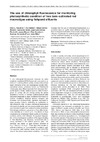Identificador persistente para citar o vincular este elemento:
https://accedacris.ulpgc.es/jspui/handle/10553/48283
| Campo DC | Valor | idioma |
|---|---|---|
| dc.contributor.author | Figueroa, Félix L. | en_US |
| dc.contributor.author | Santos, Rui | en_US |
| dc.contributor.author | Conde-Álvarez, Rafael | en_US |
| dc.contributor.author | Mata, Leonardo | en_US |
| dc.contributor.author | Gómez Pinchetti, Juan Luis | en_US |
| dc.contributor.author | Matos, Joana | en_US |
| dc.contributor.author | Huovinen, Pirjo | en_US |
| dc.contributor.author | Schuenhoff, Andreas | en_US |
| dc.contributor.author | Silva, João | en_US |
| dc.date.accessioned | 2018-11-23T20:24:56Z | - |
| dc.date.available | 2018-11-23T20:24:56Z | - |
| dc.date.issued | 2006 | en_US |
| dc.identifier.issn | 0006-8055 | en_US |
| dc.identifier.uri | https://accedacris.ulpgc.es/handle/10553/48283 | - |
| dc.description.abstract | In vivo chlorophyll fluorescence measured by pulse amplitude modulated (PAM) fluorometry was used as an indicator of photosynthetic activity in tank-cultivated red algae [Gracilaria cornea and Asparagopsis armata (tetrasporophyte phase, previously known as Falkenbergia rufolanosa)] using effluent seawater from sea bream fishponds (Sparus aurata). Optimal quantum yield of indoor-grown G. cornea did not change during the period analysed (2 months). In contrast, optimal quantum yield decreased drastically in algae transferred from indoor to outdoor conditions. Maximal electron transport rate increased and photosynthetic pigments decreased in algae growing outdoors, indicating an acclimation to high irradiance. After 16 days, chlorophyll fluorescence decreased drastically and recovered partially when algae were transferred again from outdoor to indoor conditions. Falkenbergia rufolanosa was grown at three different biomass densities (4, 6 and 8 g l-1). The effects of three consecutive air compressor failure events on the photosynthetic activity were followed. An apparent degradation of the physiological conditions of the algae (resulting in their bleaching) was observed, concomitant with a strong decrease in the optimal quantum yield. This decrease was higher at algal biomass densities of 4 g l-1 than at 6 or 8 g l-1. Three days after transfer to optimal conditions, i.e., normal aeration conditions, optimal quantum yield reached values around 0.50–0.55, close to the values before stress conditions. The results revealed that the use of chlorophyll fluorescence is a powerful means to rapidly detect different stress situations in integrated cultivation of seaweeds using fishpond effluents. In particular, the optimal quantum yield of algae can be monitored regularly as an early warning of the physiological stress in cultures. | en_US |
| dc.language | eng | en_US |
| dc.publisher | 0006-8055 | |
| dc.relation.ispartof | Botanica marina (Print) | en_US |
| dc.source | Botanica Marina [ISSN 0006-8055], v. 49, p. 275-282 | en_US |
| dc.subject | 251004 Botánica marina | en_US |
| dc.subject.other | Falkenbergia rufolanosa | en_US |
| dc.subject.other | Fishpond effluents | en_US |
| dc.subject.other | Gracilaria cornea | en_US |
| dc.subject.other | In vivo chlorophyll fluorescence | en_US |
| dc.subject.other | Physiological stress | en_US |
| dc.title | The use of chlorophyll fluorescence for monitoring photosynthetic condition of two tank-cultivated red macroalgae using fishpond effluents | en_US |
| dc.type | info:eu-repo/semantics/Article | es |
| dc.type | Article | es |
| dc.identifier.doi | 10.1515/BOT.2006.035 | |
| dc.identifier.scopus | 33748624354 | - |
| dc.identifier.isi | 000241151100001 | |
| dc.contributor.authorscopusid | 7102739746 | - |
| dc.contributor.authorscopusid | 7201375018 | - |
| dc.contributor.authorscopusid | 9942278400 | - |
| dc.contributor.authorscopusid | 12142451600 | - |
| dc.contributor.authorscopusid | 6506810496 | - |
| dc.contributor.authorscopusid | 36848395800 | - |
| dc.contributor.authorscopusid | 7004836632 | - |
| dc.contributor.authorscopusid | 6508235839 | - |
| dc.contributor.authorscopusid | 7403023547 | - |
| dc.description.lastpage | 282 | - |
| dc.description.firstpage | 275 | - |
| dc.relation.volume | 49 | - |
| dc.investigacion | Ciencias | en_US |
| dc.type2 | Artículo | en_US |
| dc.contributor.daisngid | 76079 | |
| dc.contributor.daisngid | 32159578 | |
| dc.contributor.daisngid | 3826793 | |
| dc.contributor.daisngid | 1061080 | |
| dc.contributor.daisngid | 4654381 | |
| dc.contributor.daisngid | 30703540 | |
| dc.contributor.daisngid | 1473945 | |
| dc.contributor.daisngid | 4684340 | |
| dc.contributor.daisngid | 1172634 | |
| dc.utils.revision | Sí | en_US |
| dc.contributor.wosstandard | WOS:Figueroa, FL | |
| dc.contributor.wosstandard | WOS:Santos, R | |
| dc.contributor.wosstandard | WOS:Conde-Alvarez, R | |
| dc.contributor.wosstandard | WOS:Mata, L | |
| dc.contributor.wosstandard | WOS:Pinchetti, JLG | |
| dc.contributor.wosstandard | WOS:Matos, J | |
| dc.contributor.wosstandard | WOS:Huovinen, P | |
| dc.contributor.wosstandard | WOS:Schuenhoff, A | |
| dc.contributor.wosstandard | WOS:Silva, J | |
| dc.date.coverdate | Septiembre 2006 | |
| dc.identifier.ulpgc | Sí | es |
| dc.description.jcr | 1,009 | |
| dc.description.jcrq | Q2 | |
| dc.description.scie | SCIE | |
| item.fulltext | Con texto completo | - |
| item.grantfulltext | open | - |
| crisitem.author.dept | GIR IOCAG: Oceanografía Biológica y Algología Aplicada | - |
| crisitem.author.dept | IU de Oceanografía y Cambio Global | - |
| crisitem.author.dept | Departamento de Biología | - |
| crisitem.author.orcid | 0000-0003-4668-0462 | - |
| crisitem.author.parentorg | IU de Oceanografía y Cambio Global | - |
| crisitem.author.fullName | Gómez Pinchetti, Juan Luis | - |
| Colección: | Artículos | |
Los elementos en ULPGC accedaCRIS están protegidos por derechos de autor con todos los derechos reservados, a menos que se indique lo contrario.
